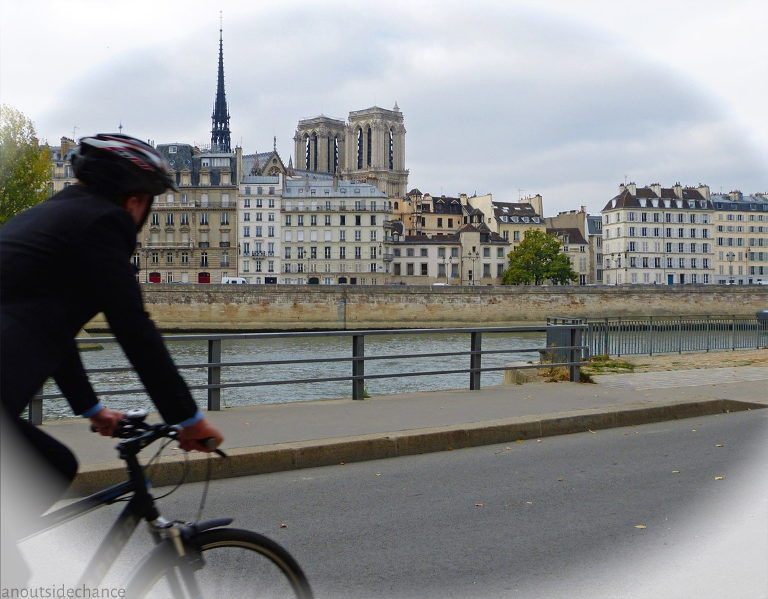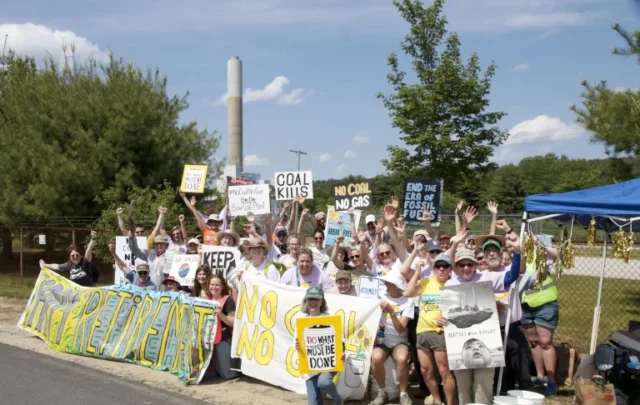Efforts to promote cycling are gathering steam in many cities for a wide variety of reasons. Campaigns may fly the banners of carbon emissions reductions, reducing air pollution for immediate health reasons, promotion of active lifestyles to combat obesity, creation of safer streets for non-auto-driving residents as a social justice issue, reduction of inefficient private-car usage as a way to fight gridlock – or all of the above.
On a recent trip to western Europe I had the chance to compare results of these campaigns so far.
The gold standard on a nationwide level, of course, is set by the Netherlands, the subject of the first two installments in this series (here and here). The Dutch have been working on this in a concerted way for forty years, and they are far ahead of the other countries I visited. Though I haven’t been to Denmark, my observations here are also shaped by the excellent book Copenhagenize, and addresses by that book’s author, Mikael Colville-Andersen, at two conferences I’ve had the good fortune to attend.
I was able to cycle about 100 kilometers each in Valencia and Paris, and 150 kilometers in London. But these are big cities and my rides weren’t nearly enough to cover all areas. My observations are also based on a single visit, so I’m not trying to write any sort of “report card” on how successful these cities’ recent programs have been.
Yet in observing which efforts are working well so far, which are showing promise, and which ones seem seriously flawed, I hope these reflections are of use to people in many other cities. Although our geographic and political situations vary a great deal, nearly all cities in industrial civilization have been dominated by car culture for a few generations, and we face many common challenges as we work back towards cities that are safe for everyone who could and should be moving about our streets.
Stealing bike lane space from pedestrian sidewalks
In both Valencia and Paris, I was immediately struck by the extensive use of paint-on-pavement to signal that “bikes belong here”. Any recognition of the rights of cyclists is a welcome first step. But in both cities, there were prominent examples of “cycle lanes” that did little or nothing to make streets either safe or convenient for cyclists, and instead were setting up more conflict between pedestrians and cyclists.
The core of Valencia has many wide arteries with relatively wide sidewalks as well as multiple lanes given to cars. Rather than carve some space out of the street for a protected bike lane (e.g., by eliminating a car lane, narrowing all car lanes slightly, or taking away some car parking space), planners have instead painted a bike lane on the already well-used pedestrian sidewalk.
This is quick and cheap and risks less pushback from the motorists’ lobby. But it results in terrible bike lanes, which wind and curve around light poles and bus shelters, and force cyclists to merge with pedestrians as they cross intersections and then sort themselves into separate areas on the sidewalk when they get to the other side. The pedestrians, quite naturally, amble into the painted bike lane frequently; many of them no doubt have strolled the same sidewalks for decades, and find it difficult and more than a little annoying to now keep in mind that cyclists might be whizzing by in what used to be a safe space for distracted walking.
Cycling these areas, then, is only slightly faster than walking – and cycling to work would not be an attractive option for most people with a commute of more than a kilometer or two.
Outside of the oldest central core of Valencia (where streets are very narrow and quiet) many side streets are just big enough for three car lanes plus narrow pedestrian sidewalks. Planners have so far chosen to make many of these streets one-way, with car parking on both sides. This leaves no room for a bike lane and guarantees slow movement for everybody, whether in car or on bike or on foot.
The obviously necessary – but obviously politically challenging – course would be to take some street space back from cars and allocate it to cyclists, while preserving sidewalk space for pedestrians. This would make both walking and biking more pleasant and safe, and would promote a gradual shift to active transportation rather than reinforcing car culture.
In Paris I saw the same timid steps to create bike lanes on busy arteries without taking away any space from cars, with similar results. The wide Boulevard de Rochechouart and Boulevard de Clichy, near the train station Gare du Nord, both feature six or more lanes devoted to cars, plus a wide park-like median for pedestrians.
With such an expansive street allowance bequeathed to them by citizens from previous centuries, could planners find a sensible way to allocate a few meters for a protected bike lane? Alas, the car space has apparently been deemed sacrosanct, and bike lanes have been painted through the formerly pedestrian-only medians. Because of many obstructions in these medians, the bike lanes shift positions frequently – on one block there may be two uni-directional lanes at the outside edges of the median, while on the next there is a bi-directional bike lane in the center of the median.
Not surprisingly pedestrians wander across the bike lanes or stand there chatting or checking their phones, and the angry ringing of bike bells and the squeak of bike brakes adds new notes to the chorus of car horns. Cyclists unfamiliar with the routing must also find the shifting cycle lane after crossing each intersection, and that can be difficult to do while also dodging cars, taxis and delivery trucks. For a bicycling tourist the whole scene may be quaintly amusing, but it would not make for a pleasant or convenient ride on any regular basis.
Routes through recreational areas
Both Valencia and Paris do have new features that make cycling a very enjoyable, calm and safe activity in particular recreational or scenic areas. This doesn’t do a lot to encourage residents to take up biking for daily commutes, but it does help make the city a more attractive place in leisure hours.
A striking feature in Valencia is the major linear park through the heart of the city, occupying the shallow valley of the Turia River which was diverted in 1969. This park is now widely used by cyclists of all ages, who travel through the park to the spectacular Ciutat de les Arts i les Ciències and other attractions.
Spacious paths for cycling and walking wind through the Turia River valley (above and below). Largely free from motor traffic, these areas offer safe recreational cycling for people of all ages, within a few blocks of dense urban districts.
On the sparsely populated south-east flank of the city, there are also some excellent cycle routes connecting the core city with the port district.
Bike route near the Valencian suburb Natzaret, with Ciutat de les Arts i les Ciències in the distance at upper left.
In Paris a new initiative has been both warmly welcomed and hotly contested. In 2016, city council approved the banning of motor vehicle traffic on a formerly busy, 3.3 kilometer roadway on the “right bank” of the River Seine. (A similar roadway was closed to motor traffic along the left bank of the Seine in 2013.)
This roadway (shown in the photo at the top of this article) provides great views of and access to many of the city’s most famous sights. Popular with walkers, runners and cyclists, the spacious route has also proven an immediate hit for people taking advantage of the new dockless scooters.
Coincidentally, while I was in Paris a court decision upheld the closure of these roads to cars, allowing the city to do much more to make these important areas attractive for active, healthy and non-polluting transport.
High-profile initiatives like the Seine roadway transformation will have little direct impact on daily transportation of most Parisians, beyond those who live or work very close to these routes. To be truly effective, a good bike route network needs to connect most residents safely to most of the destinations they normally access. Yet as first steps toward that network are concerned, it would be hard to find better places for Paris to begin than on the right bank and left bank of the Seine.
Bikes and buses: a natural fit?
In several cities on my European tour I found myself riding in “bikes and buses” lanes. On one level, this makes sense: cities wanting to smooth the passage of both public transit and active transportation might do so by setting aside a lane on a main artery for the shared use of bikes and buses. With relatively little traffic in that lane the buses can move more rapidly and thus attract more users, while also giving some official encouragement to cycling.
But is a bike-and-bus lane likely to attract new cyclists, beyond those who are already willing to brave city traffic? I don’t have the numbers, but I certainly have my doubts that people who are today unwilling to ride in car traffic will feel comfortable tomorrow in sharing a lane with even bigger buses.
In my head, I can rationalize that bus drivers are trained professionals and are much less likely to be careless, drunk, or driving while texting than the average car driver. Yet after nearly 40 years of frequent biking in busy cities, I still find it a scary adrenalin rush when a full-size city bus thunders by with inches to spare and then pulls over right to the curb in front of me.
Nowhere did the “bike and bus lane” paradigm seem more obviously flawed than in central London, where buses are nearly as numerous as taxis.
As luck would have it, my route each morning and evening in London neatly coincided with one of the much ballyhooed new “cycle superhighways”. These are painted a distinctive blue, protected for significant stretches by curbs between cyclists and cars, and they extend radially out from central London.
These routes are no doubt a significant improvement for city cyclists, and I was glad to be able to ride one into the central city each day. Yet the first time I started to relax and enjoy the ride, I was shocked to suddenly find myself turfed out into a bus-and-taxi lane.
An example of the “Cycle Superhighway” suddenly merging into a lane for buses and taxis (during rush hour) and for all motor traffic (during all other hours).
For the benefit of riders who have never seen a city bus before, a yellow sign proclaims that “This bus pulls in frequently”. If you can focus on this little yellow sign while you are being abruptly cut off by a vehicle 1000 times your weight and size, you can understand perfectly what is happening.
Though these interruptions to the bike lane were only a block or two in length, they also happened several times along the five kilometers I rode the CS2 (Cycle Superhighway) each morning and evening.
I can only imagine how frightening it would be to a first-time city cyclist who might venture out on this “protected cycle lane”, perhaps with a young child following, only to find themselves suddenly dodging buses.
In this respect the Cycle Superhighways fall short of basic standards that would be followed for any cycle route along any arterial road in any Dutch city.
This is likely one reason the Cycle Superhighways have failed, so far, to attract many riders beyond the young, fit and brave cyclists who would be riding anyway, regardless of specific bike infrastructure. On the stretch of “Superhighway” I rode frequently, weaving around buses and into the general traffic lanes is a necessary skill, unless you are content to make frequent stops and then wait patiently while many passengers embark and disembark from the bus ahead of you.
On two mornings I kept a mental count of how many cyclists passed me compared to the number of cyclists I overtook. When I maintained a pace of about 20 km/h, 8 or 10 cyclists overtook me for every one that I overtook. Nearly all of them appeared to be about half my age, though there were no children riding their own bikes, and I recall seeing only one young child being carried on a parent’s bike. This, of course, was an entirely different demographic than I had become used to while riding in Dutch cities.
The cycle riding population became more varied in the central core, with many people riding the reliable and widely available, but relatively heavy and slow, bike-share bikes. These trips tend to be short, and on many core city streets traffic is moving very slowly anyway, so biking probably feels safe enough to a much wider group of people. (Not safe in every way, mind you – there were a surprising number of cyclists wearing face masks as a defense against the polluted air.)
While the most congested streets in central London see significant use by cyclists of varying age on sturdy bike-share bikes (above), bike lanes on busier arterial roads into the core are still predominantly used by young, athletic cyclists on fast bikes (below).
The limited success so far of the Cycle Superhighways brings to mind an important principle for urban programs aiming to increase the number of cyclists:
Don’t build bike lanes for those who are cycling now. Build them for people who aren’t cycling now.
Changing a car-dominated city to a place where people of all ages feel secure in routinely biking to work, school or shopping is a difficult chicken-and-egg problem. You don’t get most urban dwellers to start riding bikes until there is wide network of safe biking spaces, connecting most people to most of their common destinations. But it’s hard to get politicians to spend political capital championing the transition to safe and clean transportation, when there are so few people biking.
It’s encouraging, then, that London’s cycling-promotion efforts go far beyond the high-profile but sparse network of cycle superhighways. As discussed in the excellent short film Cycling London’s Bicycle Super Highways, there is an accompanying push to create “Quietways” throughout London’s residential areas. This program, which simultaneously calms motor traffic while creating hassle-free routes for cyclists through residential areas, has the potential to connect many residents’ homes with major arteries. And it is only when people can safely get through and out of their own neighbourhoods on bike, that significant numbers of new riders will join those already using the protected lanes along major arteries.
As Chris Kenyon of employer association CyclingWorks says in the video,
“Our road system actively excludes certain groups from taking part in active transport. … we see fewer women, fewer older residents, and almost no children whatsoever, able to cycle in our streets. We think this is an issue of social justice. … Councils need to say, if active travel is important as a health strategy for the capital, then how do we make sure it’s available to everybody?”
Iain Simmons, Assistant Director of City Transportation, is also clear that the current preponderance of fast athletic riders is not the desired long-term goal:
“Ultimately, here in the city, we’re looking for something where actually everybody slows down. A good speed for vehicles and cyclists to go is about 10 miles an hour, because the differential between them, and someone who is walking along at 3 miles an hour in the pedestrian lane, is actually more easy to understand and deal with. Try and bring that civility, and that calmness, into people’s journeys.”
Traffic calming, then, is paramount. It is worthwhile recalling that even in The Netherlands, with their vast network of protected bike lanes, most urban streets neither have nor need specific cycling infrastructure; planners just need to ensure that car traffic on side streets is low speed and low volume, and then biking can become a safe and convenient option for people ages 8 to 80.
Just do it
Finally, it is important to remember that not all of the transition to safe active transportation is led by municipal officials. Much of the leadership comes from ordinary citizens, who conclude that cycling is a sensible option in spite of an almost complete lack of dedicated cycle infrastructure. This is especially true where previous reliance on private cars has resulted in daily patterns of gridlock, and bikes are just as fast or faster than cars whether bikes are promoted or not.
On my first morning in Paris I was cheered to see a great variety of cyclists out on the streets creating unsanctioned patterns of mobility: turning traffic-snarled one-way streets into contra-flow cycling lanes, for example, or detouring around stalled traffic by taking whichever lane had some free space at the moment.
The next morning I came across several signs warning that due to construction, circulation through the Bastille area was “difficult”. When I approached the massive, multi-spoked traffic circle in front of the Bastille opera house, I was startled to see cyclists weaving through the creeping chaos of tourist buses, cars, delivery trucks and motorcycles. After watching this pageant for 15 minutes or so I realized it wasn’t so difficult after all, and I got back on my bike to join the parade for a few laps. In closing, then, here is my brief tribute to the Parisian avant-garde</














